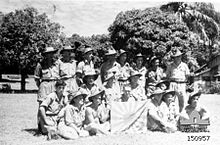
Back Operation Drake German Batalla de Goodenough Spanish Goodenoughsaaren taistelu Finnish Bataille de Goodenough French Битва за остров Гуденаф Russian Битва за острів Гуденаф Ukrainian
| Battle of Goodenough Island | |||||||
|---|---|---|---|---|---|---|---|
| Part of the New Guinea campaign of the Pacific Theater (World War II) | |||||||
 Australian soldiers with a Japanese flag captured during the fighting at Goodenough Island | |||||||
| |||||||
| Belligerents | |||||||
|
|
| ||||||
| Commanders and leaders | |||||||
|
|
| ||||||
| Strength | |||||||
| 640 |
353 initially, 285 during ground fighting | ||||||
| Casualties and losses | |||||||
|
13 killed, 19 wounded |
20 killed, 15 wounded, 1 prisoner | ||||||
The Battle of Goodenough Island (22–27 October 1942), also known as Operation Drake, was a battle of the Pacific campaign of World War II. The Allies landed on Goodenough Island, Papua, and clashed with a Japanese Kaigun Rikusentai (Special Naval Landing Force). The Japanese troops had been stranded on the island during the Battle of Milne Bay in late August 1942. "Drake Force", consisting of the Australian 2/12th Battalion and attachments, landed on the southern tip of Goodenough Island at Mud Bay and Taleba Bay on 22 October, tasked with denying the Japanese use of the island prior to the Buna campaign. Following a short but intense fight, the Japanese forces withdrew to Fergusson Island on 27 October. After the battle, Goodenough Island was developed into a major Allied base for operations later in the war.